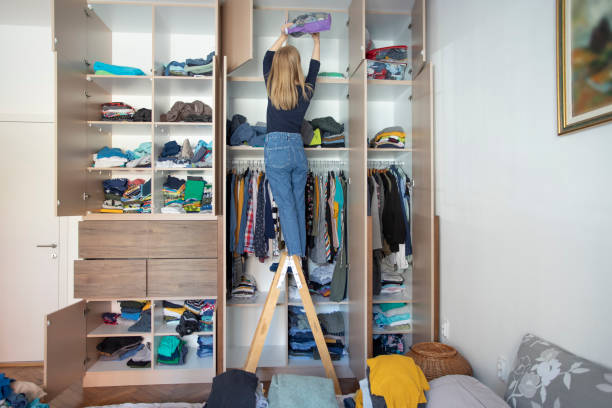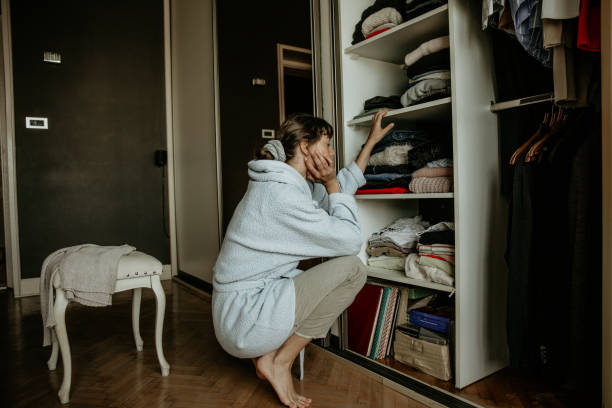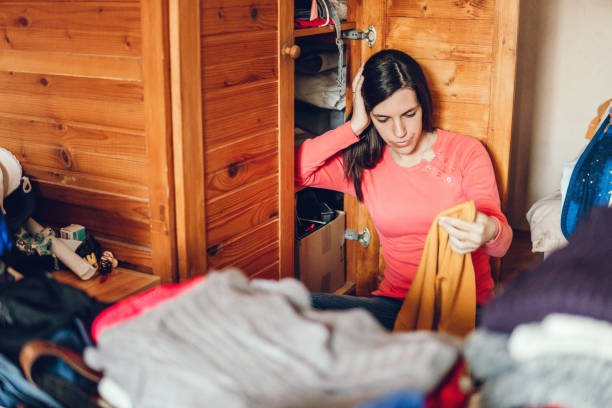If you’re like many homeowners, you may have an under-the-stairs closet that is currently underutilized or cluttered. This often-overlooked space has immense potential to become a functional storage area serving multiple purposes in your home.
With some strategic planning and creative organization, your under-the-stairs closet can become a go-to space for everything from coats and shoes to seasonal decorations and home office supplies.
This guide will walk you through each step of the process to maximize your closet’s potential, helping you create a clean, organized, and highly functional storage area.

Step 1: Clean and Prepare the Space
The first and most important step in organizing any space is cleaning. Start by completely emptying your under-the-stairs closet. This includes removing any racks, shelves, or hooks that may have been installed. Once the closet is empty, you can focus on thoroughly cleaning it. Depending on the type of flooring in your closet—carpet, tile, hardwood, or laminate—use the appropriate cleaning method to get the space spotless.
- Vacuum: If the floor is carpeted, vacuum it thoroughly to remove dust and debris. If the closet has a hardwood or tile floor, use a damp mop or cloth to clean the surface.
- Dust and Wipe: Wipe down the baseboards and any permanent fixtures, such as light switches or shelves. Pay close attention to the corners where cobwebs may accumulate.
- Address Odors: If the closet has musty smells, these can be especially prevalent in spaces with limited airflow. Consider using an odour absorber, like a charcoal bag or a box of baking soda, to eliminate unwanted odours before refilling the closet. For best results, leave it in the empty closet for at least 24-48 hours.
A clean, odour-free environment is crucial for the items you store and for ensuring that the space feels fresh and welcoming.
Step 2: Assess the Space
Once the closet is clean, it’s important to assess the space to determine the best storage options. Under-the-stairs closets often have irregular shapes, with sloping ceilings or uneven walls, so understanding the space is essential for making it work for your needs.
- Measure the Closet: Take detailed measurements of the closet, noting the height and width at various points. Pay special attention to the lowest and highest areas of the ceiling. The height of the space will directly influence what storage solutions will fit. Measure the width and depth of the floor space to determine how much you can store along the walls or on the floor.
- Consider Vertical Space: One of the biggest advantages of an under-the-stairs closet is its vertical space. Use this to your advantage by considering wall-mounted storage options like floating shelves or hooks. If the closet has a sloping ceiling, you may only be able to use part of the wall for shelving or hanging storage, so be mindful of how you position your storage solutions.
Understanding the space’s dimensions and layout will guide your decisions about the types of storage units you can incorporate.
Step 3: Decide on the Function
Now that you’ve evaluated the space, it’s time to decide what the closet will be used for. The function of your under-the-stairs closet largely depends on its location in your home. The items you store will vary depending on whether they are near your front door, in a hallway, or tucked away in another part of your house.
- Coat and Shoe Storage: If the closet is near your entryway or mudroom, it may be best to store coats, jackets, shoes, and seasonal accessories like scarves, hats, and gloves. A well-organized coat closet is essential for keeping clutter out of high-traffic areas.
- Pantry Overflow: If your kitchen pantry is too small or bursting at the seams, the under-the-stairs closet can become a convenient extension of it. You can use it to store extra food supplies, cleaning products, or rarely used kitchen appliances.
- Seasonal Decorations: Another great use for an under-the-stairs closet is as a seasonal storage area. Whether it’s holiday decorations, camping gear, or extra blankets, this closet can provide a dedicated space for items only used for the year. Keeping these items neatly stored in the closet helps free up valuable space elsewhere in the home.
Defining the purpose of your closet will help you choose the right organizational products and divide the space efficiently.
Step 4: Make Necessary Repairs
Before you begin installing shelves and hooks, inspect the closet for any necessary repairs. This is the ideal opportunity to fix any minor damages and give the space a fresh look.
- Patch Holes and Dents: If there are any holes, dents, or cracks in the walls, take a few minutes to patch them up with wall filler. This will ensure the closet looks neat, even if hidden from view.
- Repaint the Walls: While not essential, repainting the closet can bring new life. Opt for a durable, easy-to-clean paint finish like eggshell, which resists stains and is easy to wipe down. Lighter colours like white or light grey will brighten the space, making it feel larger and more welcoming, especially if it’s a dark or cramped area.
By repairing any damage and applying fresh paint, you can ensure that your closet looks great and will be more functional over time.
Step 5: Install Storage Solutions
With the closet clean and repaired, it’s time to install storage solutions that will help you keep everything organized. Depending on what you plan to store, there are many ways to optimize the space.
- Shelving: To use the vertical space, install floating shelves along the closet’s sides. Shelves are versatile and can hold everything from storage bins to small appliances, shoes, or seasonal decor. You can adjust the shelf height to maximize the storage potential if the ceiling height varies.
- Hooks: Install hooks on the back of the door or along the closet walls for items that are easy to hang, like scarves, hats, bags, or even leashes and coats if the closet is near the entryway. Hooks are a quick and affordable solution that can immediately add functionality.
- Over-the-Door Organizers: Remember to take advantage of the back of the closet door! An over-the-door rack can hold smaller items like cleaning supplies, keys, or hats. If your closet is near the front door, these racks can also be used to store shoes, hats, or even dog leashes.
- Storage Bins and Baskets: To keep smaller items organized, invest in clear plastic bins, wicker baskets, or other types of containers. Label each container for easy identification. Stackable bins help make the most of vertical space and ensure everything is neatly contained.
By thoughtfully installing the right storage solutions, you can create a functional and organized closet that meets your unique needs.
Step 6: Organize and Fill the Closet
With your storage solutions in place, it’s time to fill the closet. Be strategic about how you place your items to ensure maximum efficiency.
- Store Less-Frequently Used Items First: Place items you won’t need daily at the back of the closet. For example, holiday decorations or seasonal items can go in bins at the back, while more regularly used items like shoes or coats should be placed closer to the front for easy access.
- Group Similar Items Together: Keep similar items together to help you find what you need easily. For example, group all winter accessories (gloves, scarves, hats) in one area, or store all your extra pantry items in bins with labels that specify their contents.
- Use Labels: Label bins, shelves, and baskets to make finding items a breeze. Clear plastic bins are especially helpful because they allow you to see the contents, but labels can be a lifesaver if you have opaque containers.
By filling the closet with a logical system, you’ll ensure that the space remains organized and functional for the long term.
Step 7: Maintain the Organization
Once your under-the-stairs closet is organized, keeping it that way is essential. Make a habit of periodically reassessing the space to see if anything needs to be moved around or if new items need to be stored. Set aside time every few months to declutter and remove items that no longer serve a purpose.
Regular maintenance ensures the closet doesn’t become disorganized over time, allowing you to adjust as your storage needs change.

Practical Ideas for Your Under-the-Stairs Closet
If you’re unsure of what to store, here are some practical and creative ideas:
- Coat Closet: Use the closet as a coat and shoe rack if it’s located near the front door. Install a multi-tiered coat rack for jackets and a shoe rack to keep footwear neat and accessible.
- Pantry Overflow: If your kitchen pantry is overflowing, use the under-the-stairs closet as additional storage. Organize canned goods, dry pasta, snacks, and kitchen tools in clear containers for easy access.
- Seasonal Storage: Keep seasonal items like holiday decorations, blankets, and sporting equipment in the closet. Use storage bins or shelves to keep fragile items safe.
Maximizing this often-overlooked space can create a more functional and organized home. Whether you need extra storage for coats, kitchen supplies, or holiday decor, a little planning and the right organizational tools can transform your under-the-stairs closet into a key part of your home’s storage system.

